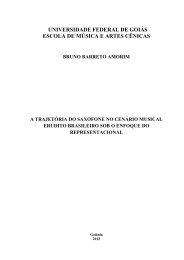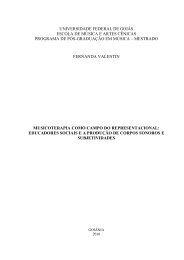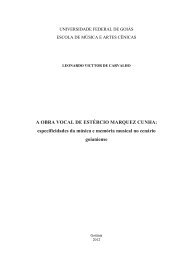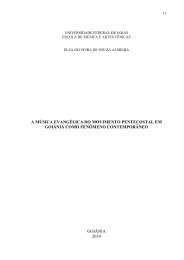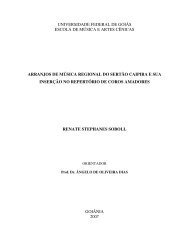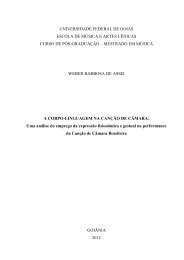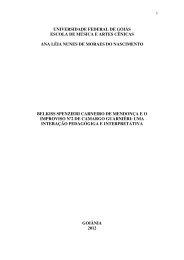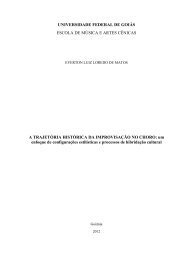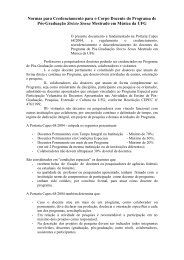Download - Mestrado em Música e Artes Cênicas - UFG
Download - Mestrado em Música e Artes Cênicas - UFG
Download - Mestrado em Música e Artes Cênicas - UFG
You also want an ePaper? Increase the reach of your titles
YUMPU automatically turns print PDFs into web optimized ePapers that Google loves.
help to create an explosive intensity. In measure 38, a meno marking creates contrast. The tenuto<br />
accents converge to dramatically <strong>em</strong>phasize the passage as well (Example 1.2).<br />
Example 1.2: Estudo I, mm. 30-42.<br />
The flutter tongue in measure 42 announces a series of extended techniques. The clarinetist<br />
may or may not perform the flutter tongue from the preceding measure, particularly after<br />
the last note of the triplets. I connect measures 41 to 42 to help build to the peak of this passage.<br />
However, other players may prefer having a slight gap in between in order to better perform<br />
the flutter tongue.<br />
I use four sequences of multiphonics, presented as follows: I, II, III, IV, III, I, II, and I (see<br />
measures 43 to 49). They are first introduced at a slow t<strong>em</strong>po to <strong>em</strong>phasize on their timbral effects<br />
and then are repeated. A fingering chart for th<strong>em</strong> multiphonics is available in the score; however,<br />
the musician may use a fingering that best fits his or her own acuity and equipment.<br />
The next passage includes humming, combined with circular breathing, microtones, vibrato,<br />
and glissando. A flutter tongue then follows, the purpose of which is to create tension; it<br />
culminates with a trill. Immediately following, there is a rapidly descending and ascending passage<br />
that incorporates double tongued staccato. Large leaps culminate on a high D7. The coda<br />
begins quietly and gradually evolves to a forte, where a sextuplet of thirty-second-note group is<br />
attacked. The piece ends with another wide leap, from an accented high C7 to an accented low<br />
F#3 (Example 1.3).<br />
Example 1.3: Estudo I, mm. 79-80.<br />
Comunicações Orais 57



